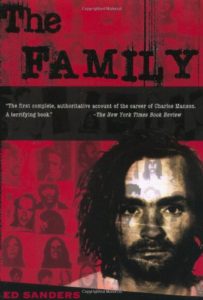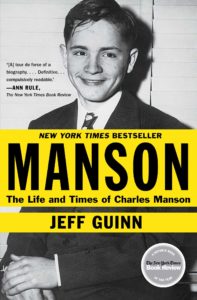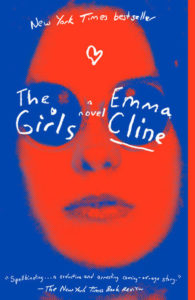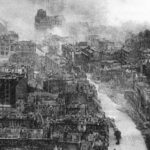Like many bookworms my age, I devoured Vincent Bugliosi’s account of the notorious 1969 homicide case back when it was a bestseller and I was perhaps too young for such horrific material; definitely too young to remember the headlines. I revisited my dog-eared copy last summer while researching my latest suspense novel, Little Girl Lost, about a sixties cult killer loosely based on Charles Manson. After Helter Skelter, I made my way through a stack of titles that explored the man and murders from various angles. I finished writing my book right around the time that Manson drew his last breath in a prison hospital after serving out his the life imprisonment sentence converted from the death penalty after it was abolished.
Why, I wondered, does Manson continue to captivate? There have been other notorious killers in the past five decades. Some were more prolific; most more handsome, a few downright charismatic. Yet it is Manson who remains the quintessential antihero, making headlines even from beyond the grave courtesy of several key elements.
- Celebrity Connection: The Tate-LaBianca murders—the setting, the victims, the motive, the mastermind himself—are laced with Hollywood fame and privilege, or killer’s unrequited desire for both. Iconic players range from doomed starlet Sharon Tate and her widower, Roman Polanski, to the Beatles and Beach Boys.
- Mystique: How can a man have been convicted of murders he didn’t even commit? How did an uneducated, unkempt, impoverished Appalachian convict convince not just one attractive, well-bred young woman, but many—to slaughter innocent people on his behalf? Why did his “girls”—the ones on the outside, and the murderesses facing the death penalty–continue to stand by him after he was imprisoned and the brutal truth came out?
- Religion: Before he rounded up his followers and moved to a commune, Manson was a street preacher whose fiery sermons drew crowds. Convinced he was the second coming of Jesus Christ, he interpreted his name as “man’s son” and honed an idealogy enhanced by apocalyptic bible passages from Revelations.
- Timing: The late 1960s were turbulent in America, marked by war, assassinations, protests, drugs, and violence. Hippie Manson and his followers played into the worst fears of the middle class American establishment. As the era drew to a close, long-haired, strung out Manson seemed a symbol of counter culture gone horribly wrong.
- Accessibility: Charles Manson didn’t slink into the shadows of history to serve his sentence, prison-shorn head bent in resignation. His was held high, emblazoned with a hand-carved swastika. He reveled in attention and seemed to embrace his own batshit craziness with a wild-eyed willingness to talk to the press—Tom Snider, Charlie Rose, Diane Sawyer—the higher profile, the better.
This selection of books, ranging from true crime to a novel to autobiographies—including Manson’s own—provides additional insight:
Manson in His Own Words, as told to Nuel Emmons
This first-person account of Charles Manson’s life may not cause you to sympathize with a cold-blooded killer, but you just might feel sorry for the unwanted, lonely, abused little boy depicted here. He describes how he wept after being abandoned by his jailbird mother, causing his uncle to label him a sissy and force him to wear girl’s clothing on his first day of school. Tormented by bullies, scrawny, and impoverished, young Charlie compensated with mischievous, and later dangerous, antics. As a complex character emerges from the traumatic childhood, the tone is factual and unapologetic, rather than playing his victimized youth and vulnerability for pity. Manson has proven himself to be a manipulative egomaniac, so part of the fascination—and challenge—with this read is to weigh just how much truth lies in this enthralling and possibly embellished self-portrait.
Manson: The Life and Times, by Jeff Guinn
Chronicling the evolution of perhaps the most diabolical American criminal mastermind of all time, Guinn unfurls both characterization and life events against a lurid historical backdrop. An aura of inevitability builds as we follow Manson from Depression-Era Appalachia to the Summer of Love in Haight-Ashbury to a swingin’ sixties Hollywood scene populated by household names. He embraced sex, drugs, and rock and roll as the ideal antidote to his miserable childhood and the decade of depravation he’d spent behind bars. The star-struck, fame-hungry Manson depicted here was on a lifelong mission for female acceptance and notoriety. He certainly found both, though perhaps not quite in the way he’d envisioned.

The Family, by Ed Sanders
This lengthy volume vividly portrays Charles Manson, his followers, and his crimes, framed within an ever-escalating march toward the pivotal events of August, 1969. Laced with dialogue and stark violence, Sanders’ blow-by-blow account of the notorious Tate-LaBianca murders is meticulously fleshed out and almost unbearable to read. These scenes occurred at roughly the book’s halfway point. The aftermath encompasses the chase, capture, criminal investigation, and legal proceedings. The whole is interspersed with ominous details about a series of later unsolved murders and the brainwashed unrepentant “girls,” even behind bars with Charlie and camped out on courthouse sidewalks, chanting and singing with Xs carved into their foreheads. The book concludes with a satisfying, if outdated, circa late 1980s “Where Are They Now?”
Member of the Family, by Dianne Lake and Deborah Herman
I read this recent autobiography as an audio book narrated by the author herself, in a tone that was by turns conversational, laced with sorrow, or taut with fury. I was prepared not to relate to Diane Lake, but came away with tremendous empathy and respect. This chilling firsthand account paints a vivid picture of how an ordinary midwestern girl became perfect prey for the Manson family after her wholesome, respectable one fell apart. Swept into the sixties counterculture and eventual drug addiction, Lake’s wayward parents all but handed their preteen over to a groovy, pervy guru named Charlie. There is no question that she was a victim, from her disturbing account of childhood incest to neglectful parents to Manson himself. In looking back after having led an exemplary adult life, she has proven extraordinarily resilient with an almost unsettling capacity for forgiveness, not necessarily pointing a finger at anyone other than the cult leader.
The Girls, by Emma Cline
A fictional account of a strikingly similar story, The Girls provides a perfect companion to Member of the Family. Evie, our troubled teen heroine, falls under the spell of a murderous hippie guru and his “girls” in a familiar scenario that clearly evokes Charles Manson and his followers. At its heart, this is a coming of age tale with universal, relatable themes of adolescent insecurity, parental foibles, and the malleability of a young woman searching for self, and for acceptance. As Evie says, “I knew just being a girl in the world handicapped your ability to believe yourself. Feelings seemed completely unreliable, like faulty gibberish scraped from a Ouija board.” A beautifully written literary first novel, this is the kind of book that invites you to linger over an exquisite phrase while somehow maintaining page-turner pacing.





















